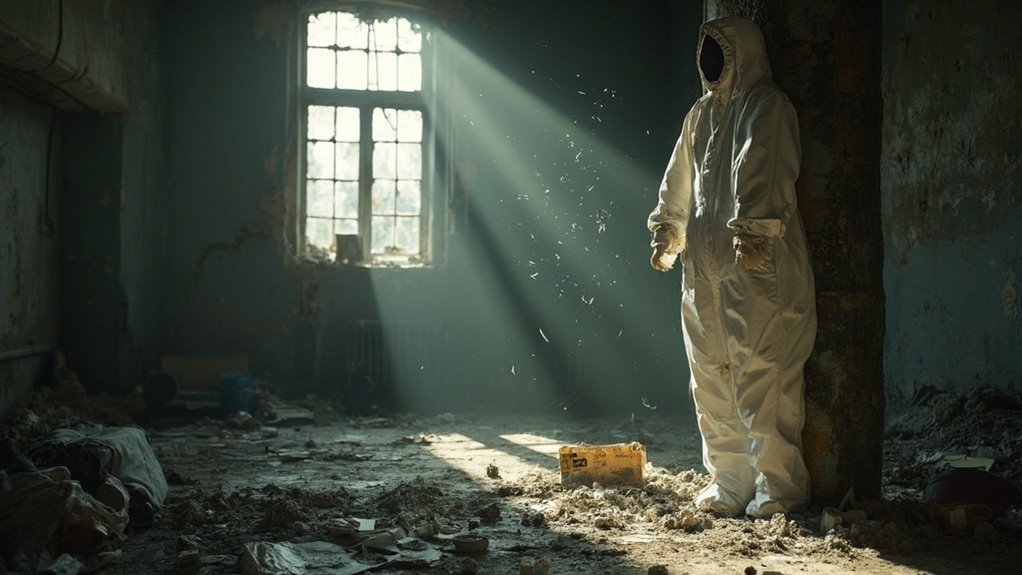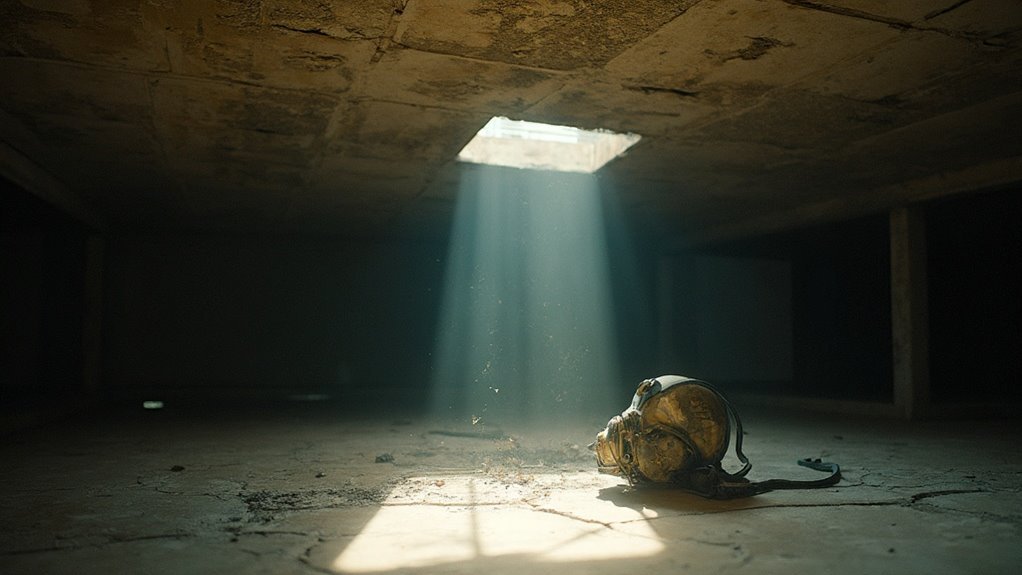Asbestos hides in many older homes, and exposure can lead to severe health issues like lung cancer and mesothelioma. You might not see asbestos, but it can become airborne during renovations, putting you and your family at risk. Testing is crucial—it's often required before any remodeling. Identifying asbestos allows for safe removal and helps prevent long-term health consequences. Even minimal exposure can lead to serious diseases years later. Regular testing helps you manage these risks effectively. If you want to safeguard your home and health, you'll uncover effective strategies to tackle asbestos hazards.
Understanding Asbestos Risks

As you navigate older buildings or consider renovations, it's vital to understand the risks associated with asbestos. This naturally occurring mineral was prized for its unique properties, such as heat resistance and strength, making it a popular choice in construction and insulation materials for decades. Historical usage of asbestos spans various industries, including automotive and manufacturing, where it was incorporated into products like shingles, tiles, and even mechanical equipment.
In buildings, you might find asbestos lurking in unexpected places, from insulation to flooring materials. Its fibers can become airborne when disturbed, making renovations or demolitions particularly risky. Even natural disasters can expose you to these hidden dangers, as damaged structures may release asbestos into the air. Moreover, it's important to remember that exposure isn't limited to the worksite; family members of asbestos workers can likewise be at risk because of fibers brought home on clothing. All asbestos fibers are harmful if breathed, which highlights the urgency of addressing potential exposure. Additionally, asbestos-related diseases may develop 20 to 50 years post-exposure, underscoring the long-term health risks involved.
To mitigate these risks, consider testing for asbestos before starting any work. Understanding its historical usage and properties will empower you to make well-informed choices, ensuring the safety of yourself and those around you.
Health Consequences of Exposure
Exposure to asbestos poses serious health consequences that can profoundly impact individuals' lives. Asbestos is known for its carcinogenic effects, leading to fatal illnesses such as malignant mesothelioma, lung cancer, and asbestosis. The risk of developing these diseases increases considerably with cumulative exposure, meaning that the longer and more frequently you encounter asbestos fibers, the greater your risk becomes.
Many lung disease symptoms, such as persistent cough, chest pain, and difficulty breathing, may not manifest until years after initial exposure. In fact, lung cancer or asbestosis often appears 15 years or more after exposure, while mesothelioma may take 30 years or longer. Even individuals who experience secondhand exposure, like family members of asbestos workers, face considerable health risks.
Importantly, there's no safe level of asbestos exposure; even brief encounters can lead to serious health issues. Federal regulations require asbestos testing before renovations or demolitions, making it essential for homeowners to be aware of their potential exposure. Understanding these health consequences is vital for anyone with a history of exposure, as early detection and intervention can be life-saving. By recognizing the dangers of asbestos, you empower yourself to take preventive measures against these potentially devastating diseases.
The Need for Asbestos Testing

Regular asbestos testing is imperative for guaranteeing safety and compliance in environments where asbestos may be present. This process protects you, your workers, and the public from the serious health risks associated with asbestos exposure. Legal requirements mandate asbestos testing before any demolition or renovation of older buildings, highlighting the significance of adhering to these regulations to avoid significant legal and financial penalties.
Asbestos identification techniques, such as stereomicroscopy and Polarized Light Microscopy (PLM), play an important role in accurately detecting asbestos fibers. Testing methodologies likewise include Transmission Electron Microscopy (TEM) and Scanning Electron Microscopy (SEM), which are critical for analyzing fine asbestos fibers and airborne samples. Regular environmental monitoring through these techniques guarantees that any contamination is assessed and managed effectively.
Moreover, thorough asbestos surveys involve visual inspections, bulk sample extractions, and laboratory analysis, leading to informed remediation recommendations. By prioritizing asbestos testing, you safeguard not only your health but also comply with regulatory standards, making it an indispensable step in any renovation or demolition project. Don't underestimate the necessity of testing—it could very well save your life.
Asbestos in Older Homes
Older homes often harbor hidden asbestos materials that can pose significant health risks. If your home was built between 1930 and 1950, it may contain asbestos in insulation, textured paint, and patching compounds. Asbestos use peaked between 1900 and 1980, and remnants could still be present in homes until the 1990s. Common locations include roofing and siding shingles, insulation around furnace ducts, and floor tiles.
Identifying asbestos isn't always straightforward. Asbestos identification methods often require professional testing, as appearance alone can be misleading. If you're planning renovations, consider home inspection tips: perform visual checks for damaged materials and limit access to potentially hazardous areas. Remember, the risk of exposure increases if asbestos-containing products are disturbed or damaged.
Taking proactive steps can help protect your health. If you suspect the presence of asbestos, seek professional assistance for thorough inspections and testing. Knowing the risks associated with asbestos exposure, including lung cancer and asbestosis, emphasizes the importance of vigilance in older homes. Prioritize safety by being informed, and ascertain your living environment is free from hidden dangers.
Safe Asbestos Removal Practices

When dealing with asbestos removal, adhering to safe practices is fundamental to minimize health risks and guarantee effective containment. Using appropriate removal techniques and safety protocols can protect both workers and the surrounding environment.
Here are three key practices to follow:
- Erect Barriers: Establish physical barriers and signage to restrict unauthorized access to the removal area.
- Use Wet Removal Techniques: Saturate asbestos-containing materials to suppress fiber release during handling.
- Implement Decontamination Procedures: Confirm thorough decontamination for both workers and equipment before exiting the work area.
It's imperative to seal off removal areas with polyethylene sheeting and utilize negative air pressure units equipped with HEPA filtration systems. Proper ventilation reduces airborne fiber buildup, further enhancing safety. Training sessions that cover removal plans, safety protocols, and emergency procedures are critical to prepare workers effectively. Remember, using personal protective equipment (PPE) like respirators, gloves, and coveralls protects you during the removal process.
Regulatory Compliance and Responsibilities
Effective asbestos removal practices are only part of the larger framework of guaranteeing safety and compliance in asbestos management. You must understand the various regulatory frameworks and compliance strategies that govern asbestos handling. Key regulatory bodies like the Health and Safety Executive (HSE), OSHA, and the EPA set strict guidelines for asbestos surveys, notifications, and management plans.
| Regulatory Body | Key Responsibilities |
|---|---|
| HSE | Control of Asbestos Regulations 2012 |
| OSHA | Asbestos surveys before work, safety measures |
| EPA | Toxic Substances Control Act (TSCA) |
As an employer or property owner, you have a duty to manage asbestos risks. This includes conducting certified surveys, evaluating risks, and notifying all relevant parties about asbestos presence. Compliance isn't just a legal obligation; it's essential for protecting public health and the environment. Furthermore, keeping up with compliance deadlines and updates from federal and state agencies is critical to avoid penalties and guarantee a safe working environment. By adhering to these regulations, you play an important role in safeguarding yourself, your employees, and the community from asbestos-related dangers.
Long-Term Health Prevention Strategies

To effectively prevent long-term health issues related to asbestos exposure, regular asbestos testing is vital for identifying potential hazards in your environment. When renovating, adopting safe practices can greatly reduce the risk of disturbing asbestos-containing materials. Additionally, relying on professional removal services guarantees that any asbestos is handled and disposed of safely, minimizing your exposure.
Regular Asbestos Testing Importance
Regular asbestos testing plays a fundamental role in long-term health prevention strategies, safeguarding individuals from the hidden dangers of this hazardous material. By prioritizing asbestos testing, you can greatly mitigate risks associated with exposure and guarantee a safer environment for yourself and others.
- Compliance with Regulations: Regular testing guarantees adherence to health and safety regulations, protecting both workers and the public.
- Early Detection: Identifying asbestos presence early can prevent unnecessary exposure, especially in older buildings constructed before the 1980s.
- Legal Protection: Many jurisdictions mandate testing before renovations or demolitions, safeguarding property values and insurance implications.
Conducting thorough risk assessments through regular asbestos testing is imperative for long-term health. As exposure can lead to serious conditions like lung cancer and mesothelioma, understanding contamination levels allows for proactive measures. In addition, consistent documentation during assessments aids in future inspections and remediation efforts. With no safe level of asbestos exposure, maintaining vigilance through ongoing testing is critical, providing peace of mind and promoting ecological health. By committing to regular testing, you're not only protecting yourself but contributing to a safer community.
Safe Renovation Practices
Prioritizing safe renovation practices is vital for anyone planning to undertake construction or remodeling projects, especially in older buildings that may contain asbestos. Before starting any work, conduct thorough asbestos testing to identify hazardous materials. If you find asbestos, use safe materials and tools designed for such environments. This includes HEPA vacuums and wet cleaning methods that minimize fiber release during cleanup.
Mark hazard areas to prevent unauthorized entry, and always wear personal protective equipment (PPE) to limit exposure. When removing asbestos materials, avoid breaking them into small pieces, as this can release harmful fibers into the air. Instead, wetting agents can help reduce fiber release and make removal safer.
Once the removal is complete, verify the work area is thoroughly cleaned, following lab analysis recommendations. It's also vital to implement safe work practices based on potential asbestos disturbance and to educate everyone involved about the associated hazards. By adopting these safe renovation practices, you not only protect your health but additionally contribute to the long-term safety of everyone in your environment. Remember, awareness and preparation are key in preventing asbestos-related health issues.
Professional Removal Services
When dealing with asbestos, hiring professional removal services is essential for guaranteeing both immediate safety and long-term health prevention. These experts possess the specialized knowledge required for effective asbestos assessment and removal techniques, minimizing health risks associated with exposure.
Here are three key benefits of utilizing professional services:
- Regulatory Compliance: Certified professionals guarantee adherence to local, state, and federal asbestos regulations, protecting you from legal liabilities.
- Expertise and Safety: With OSHA-certified staff, these companies promise safe removal, greatly reducing the risk of lung cancer and mesothelioma.
- Long-Term Prevention: Effective removal techniques prevent future exposure to harmful asbestos fibers, safeguarding your health for years to come.
Frequently Asked Questions
How Can I Tell if My Home Has Asbestos?
To identify asbestos in your home, check common materials like attic insulation, vinyl floor tiles, and textured ceilings. Utilize asbestos identification methods such as professional testing to guarantee accurate results and maintain safety.
What Are the Costs Associated With Asbestos Testing?
Asbestos testing costs typically range from $231 to $778, with professionals evaluating your home's size and complexity. Understanding these costs helps you budget for crucial evaluations, ensuring safety in your living environment.
Can I Remove Asbestos Myself?
You shouldn't attempt DIY asbestos removal because of strict regulations and potential asbestos exposure symptoms. Improper handling can lead to serious health risks, so hiring licensed professionals is always the safest choice for your well-being.
How Long Does Asbestos Testing Take?
Asbestos testing duration can feel like an eternity, but it usually takes just a few hours for on-site procedures, followed by lab analysis that can range from 24 hours to a week for results.
Are There Safe Alternatives to Asbestos?
Yes, there are safe alternatives to asbestos. Consider using cellulose fiber, synthetic fibers, or polyurethane foams. These asbestos substitutes provide excellent insulation and fire resistance, ensuring safety without compromising performance or environmental standards in your projects.
